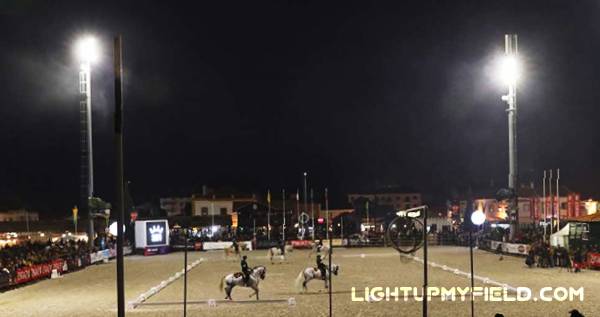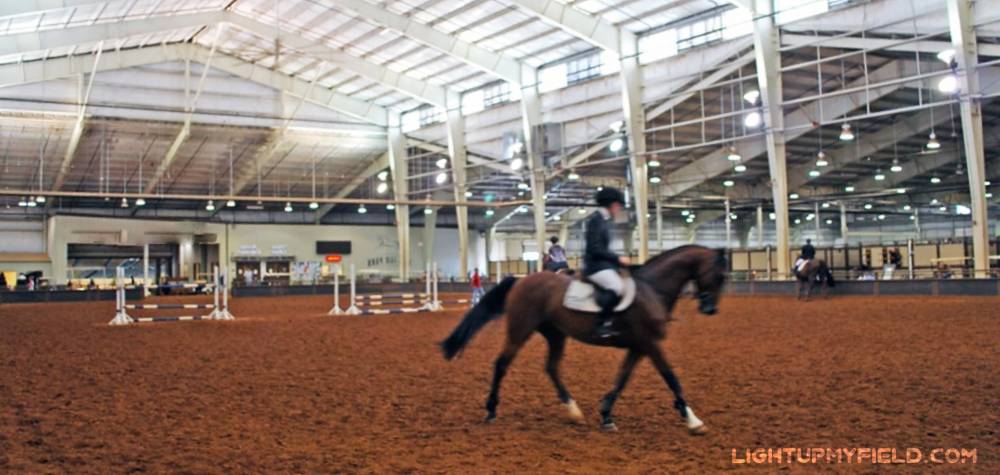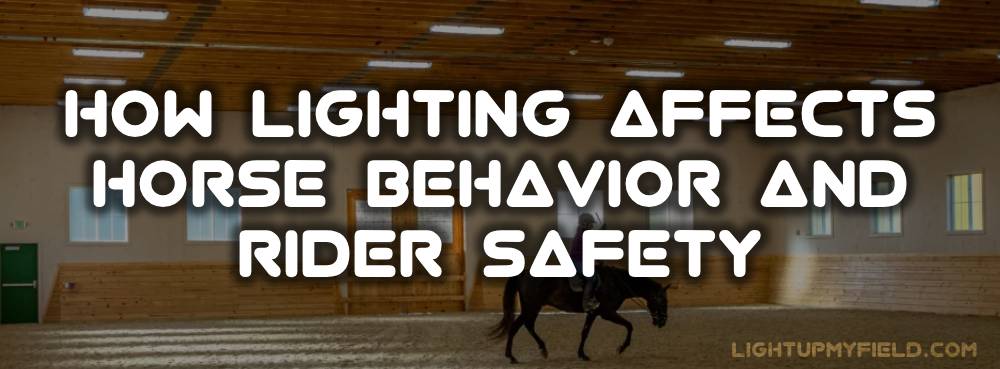When you think about riding, your mind probably jumps to things like the horse’s temperament, the rider’s skill, or the footing of the arena. But one often overlooked factor that plays a big role is lighting. How a riding space is lit can seriously impact how horses react and, in turn, how safe riders feel. It’s not just about being able to see well—it’s about creating an environment where horses feel comfortable and riders can stay confident.
Table of Contents
ToggleWhat Happens When Lighting Isn’t Right for Horses and Riders?
 Lighting that’s uneven, too dim, overly bright, or full of glare can mess with horses in ways you might not notice right away—but that definitely add up. Horses’ eyes are way more sensitive than ours, and they see the world in a totally different way. Unlike humans, horses have a wide field of vision—almost 350 degrees—and rely on their sight to feel safe and figure out their surroundings. When lighting is off, it can throw them off balance, cause confusion, or even make them stressed out.
Lighting that’s uneven, too dim, overly bright, or full of glare can mess with horses in ways you might not notice right away—but that definitely add up. Horses’ eyes are way more sensitive than ours, and they see the world in a totally different way. Unlike humans, horses have a wide field of vision—almost 350 degrees—and rely on their sight to feel safe and figure out their surroundings. When lighting is off, it can throw them off balance, cause confusion, or even make them stressed out.
The Trouble with Uneven Lighting
One of the biggest problems comes from poor lighting uniformity. If parts of the arena are bright while other spots are shadowy or dark, horses often hesitate or get jumpy. Picture this: you’re walking confidently on a clear path, then suddenly step into a patch of deep shadow. It feels like the ground just changed, or maybe there’s something lurking you can’t quite see. For horses, this isn’t just uncomfortable—it can cause them to stop abruptly, spook, or refuse to move forward. Riders end up dealing with sudden stops or unpredictable reactions, which can be frustrating or even dangerous.
Studies show that about 30% of horses react nervously to changes in lighting conditions, especially in indoor arenas where shadows can be harsh. For riders, that means having to be extra ready for surprises—sometimes without much warning. And when trust between horse and rider gets shaky, it affects every part of your ride.
When Lights Are Too Bright
On the other end of the spectrum, lighting that’s too bright can be just as troublesome. Overhead lights that blast down or reflections from shiny walls or puddles can cause horses to squint or even try to look away. Horses aren’t big fans of bright, direct light in their eyes. It can make them nervous or reluctant, and sometimes they might refuse to perform certain moves just because they’re uncomfortable.
Bright lighting doesn’t only mess with the horse’s eyes. For riders, having to constantly adjust to their horse’s behavior because of lighting distractions can be exhausting. In fact, riding injuries related to sudden horse reactions happen in about 15% of accidents caused by environmental factors, and lighting plays a big role in that. When horses behave unpredictably due to glare or bright spots, riders have less control, making the whole situation riskier.
When Lighting is Too Dim
Dim lighting might sound like less of a problem, but it’s definitely not ideal. Horses need to see well enough to keep their balance and stay confident while moving. In a dark arena, horses can struggle to pick out footing changes, jumps, or other obstacles. That uncertainty can make them hesitant or clumsy.
For riders, dim lighting makes it harder to read their horse’s body language or to judge distances correctly—two things that are super important to avoid trips or falls. Research into indoor riding accidents shows that poor visibility contributes to around 25% of mishaps related to footing problems.
How Glare Can Turn a Calm Ride Upside Down
Glare is one sneaky lighting problem that often gets overlooked. When lights are badly positioned, or sunlight streams in at certain angles, the glare can temporarily blind a horse or rider. Horses might suddenly shy or bolt because they get startled when their vision is interrupted like that.
Glare doesn’t just scare horses—it makes it hard for riders to see what’s ahead clearly, which can increase the chance of accidents. Imagine trying to control a horse when you’re basically looking into a bright spotlight; it’s no wonder riders feel less in control and more on edge during these moments.
To put it in perspective, about 18% of riders report glare-related issues affecting their ability to ride safely, especially in arenas with large windows or poorly angled artificial lighting.
How Lighting Really Affects a Horse’s Mindset
 Horses aren’t just big animals you ride—they’re prey animals, which means their whole survival system is built around spotting danger fast. Their senses, especially their vision, are finely tuned to pick up on anything unusual or threatening in their environment. So when the lighting around them is patchy, harsh, or inconsistent, it can really mess with how safe they feel. Their eyes are constantly working to adjust to sudden changes in light and dark, trying to figure out what’s real and what might be a shadow or a trick of the light. That constant adjustment can ramp up their anxiety and make them more skittish than usual.
Horses aren’t just big animals you ride—they’re prey animals, which means their whole survival system is built around spotting danger fast. Their senses, especially their vision, are finely tuned to pick up on anything unusual or threatening in their environment. So when the lighting around them is patchy, harsh, or inconsistent, it can really mess with how safe they feel. Their eyes are constantly working to adjust to sudden changes in light and dark, trying to figure out what’s real and what might be a shadow or a trick of the light. That constant adjustment can ramp up their anxiety and make them more skittish than usual.
In fact, research shows that horses exposed to uneven lighting conditions show signs of stress in up to 40% of cases, especially when shadows move or flicker unexpectedly. That’s a pretty big number considering how much lighting varies in indoor arenas or outdoor spaces at different times of the day.
Why Color Perception Matters More Than You Think
Another interesting thing about horses is how they see colors. Unlike us humans, who can see a wide range of colors vividly, horses mostly see in shades of blues and greens. Reds and oranges? They look pretty dull or muted to them. So when the lighting distorts natural colors—say, a warm yellowish light casts a glow on the arena floor or walls—it can make certain areas look darker or even different than they actually are.
Imagine a corner of the arena under a warm-toned light. To us, it might just look cozy or normal. But for a horse, that same corner might look like a deeper, almost mysterious shadow. That can make them hesitate or refuse to step forward. Studies on equine vision suggest that lighting which alters color perception can increase a horse’s hesitation by up to 25% during training sessions. This hesitation isn’t just frustrating—it can slow down progress and cause tension between horse and rider.
The Impact of Sudden Lighting Changes
Then there’s the issue of going from one lighting environment to another too quickly. Think about moving from bright sunlight into a dimly lit indoor arena, or vice versa. Humans adjust pretty fast to these changes, but horses? Their eyes take longer to adapt. During that adjustment time, they might be less aware of what’s right in front of them, which can throw off their balance, focus, and confidence.
This “transition lag” in vision can last several seconds, and in that brief window, horses are more prone to spook or behave unpredictably. One study looking at horses’ reactions to lighting changes found that sudden transitions increased startle responses by nearly 30%. For riders, this means you’ve got to be extra patient and ready for those moments where your horse might hesitate or act out of the ordinary.
How Can You Improve Lighting in Your Riding Arena?
Getting the lighting right in a riding arena isn’t just about throwing in a bunch of bulbs and calling it a day. It’s really about creating a space where the light feels balanced, steady, and comfortable for both the horse and rider. When done well, it can totally change the vibe—making rides smoother and safer because the horse isn’t distracted or stressed by weird shadows or glaring spots.
Focus on Even Lighting Across the Arena
One of the biggest things to keep in mind is uniformity. Lighting should be spread out evenly so that the whole arena has a consistent level of brightness. That means avoiding those annoying bright spots right under a light with darker patches right next to it. Horses are super sensitive to these changes and can easily get thrown off by sudden shadows or uneven light.
Using multiple light sources that cover every corner and angle helps a lot. Ideally, you want to make sure the arena is lit at around 200 to 300 lux, which is bright enough for clear visibility without being blinding. Some indoor arenas fall short of this, with lighting levels dropping below 100 lux in places, which can lead to all sorts of issues with horse behavior and rider safety.
Choosing the Right Type of Lighting
The type of bulbs you pick makes a big difference too. LED lights have become the go-to option for many riding arenas because they provide a crisp, natural-looking light that’s easy on the eyes—both human and horse alike. They also don’t flicker like some older fluorescent or incandescent bulbs, which can be a real distraction or even unsettling for horses.
Flickering lights can cause horses to become anxious or nervous, so switching to LEDs can reduce those subtle stress triggers. Plus, LEDs don’t get as hot, which is a bonus for indoor arenas that can already get warm during busy training sessions.
Positioning Lights to Cut Down on Glare

Glare is one of the sneakiest lighting problems. It’s not always obvious, but poorly placed lights can shine right into a horse’s eyes or reflect off shiny floors and mirrors, creating spots that are almost blinding. This can make horses squint or shy away, which obviously isn’t what anyone wants during training.
To avoid this, lights should be positioned carefully—ideally mounted high and angled so the beam is directed downward and doesn’t hit the horse’s face directly. Sometimes using diffusers or frosted light covers helps spread the light more evenly and softly, cutting down on those harsh reflections. Studies show that reducing glare in arenas can decrease horse spooking incidents by up to 20%, making a noticeable difference in overall calmness.
Managing Natural Light in Your Arena
If your arena has windows or skylights, natural light becomes part of the lighting equation—and that can be a bit tricky. While natural light is usually great, it can cause sudden bright patches or glare when the sun moves or clouds pass by. That flickering sunlight can catch horses off guard or create those uneven lighting patches we talked about earlier.
To tackle this, many arenas use window shades, films, or screens to soften incoming sunlight and keep the lighting more consistent throughout the day. The idea is to avoid sharp contrasts between bright sunbeams and shadows. By managing natural light, you create a steadier environment where horses feel more confident and focused.
Small Changes, Big Impact
Making these lighting adjustments doesn’t have to mean a massive overhaul. Sometimes just adding a few extra light fixtures in darker spots or swapping out old bulbs for LEDs can make a huge difference in how the arena feels. The better the lighting, the more at ease your horse will be—and the safer and more enjoyable your rides will become.
When horses aren’t worried about sudden shadows or squinting into bright spots, they’re able to relax and perform better. For riders, that means fewer surprises and a lot more control over the ride. Investing in smart, well-planned lighting really pays off in creating a space that works for everyone involved.
A Few Things to Keep in Mind When Upgrading Arena Lighting
Upgrading lighting can seem daunting or expensive, but thinking about it like an investment in safety and performance makes a difference. Even small changes, like repositioning a few lights or swapping bulbs, can improve the feel of the arena.
Consulting with a lighting professional who understands equestrian needs can be a game-changer. They can recommend the right fixtures, brightness levels, and layouts that work best for your space and budget.
Lastly, it’s always good to get feedback from riders and trainers who use the arena daily. They’ll notice how horses react or where visibility feels tricky, helping you tailor the lighting to real-world needs.

